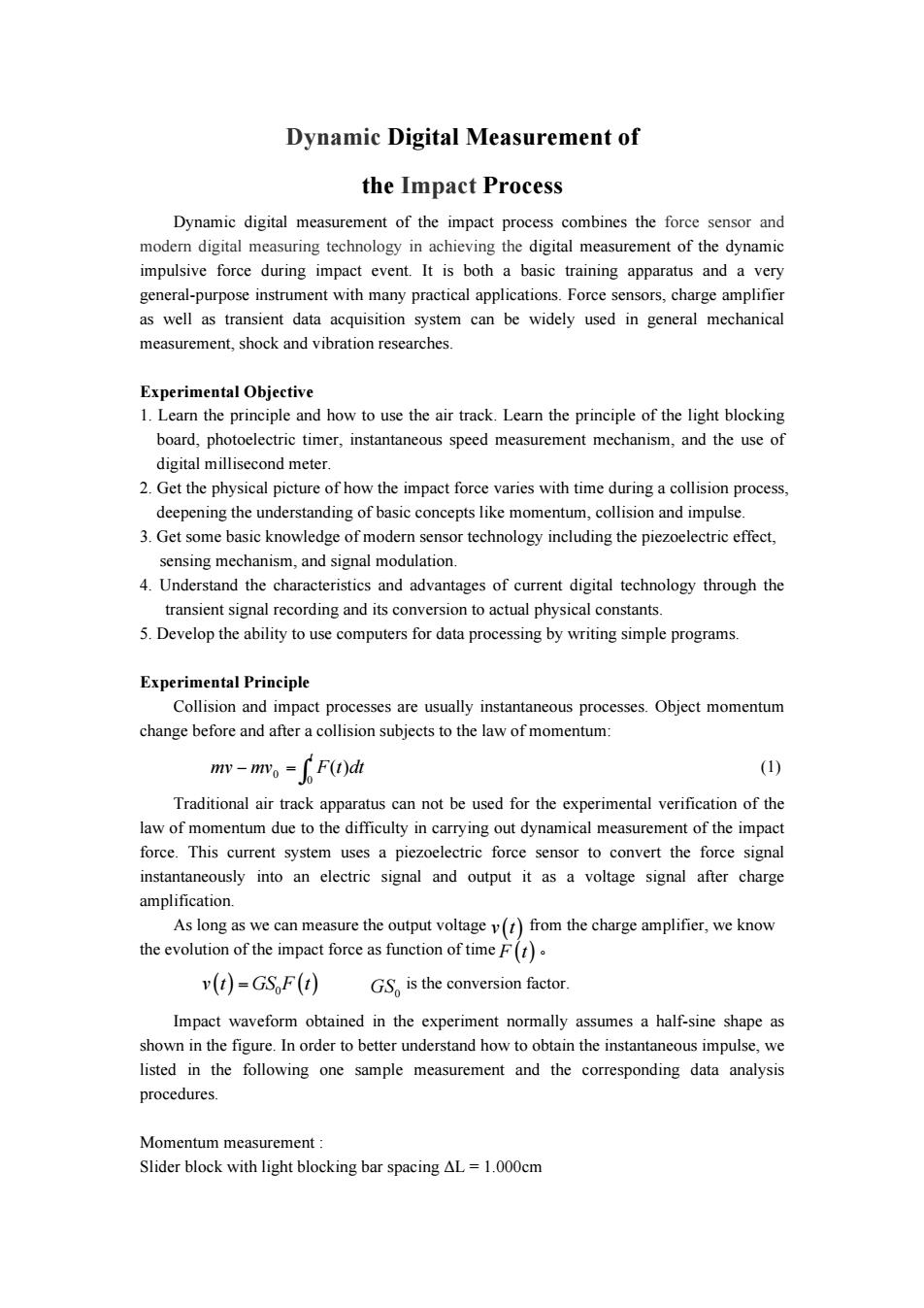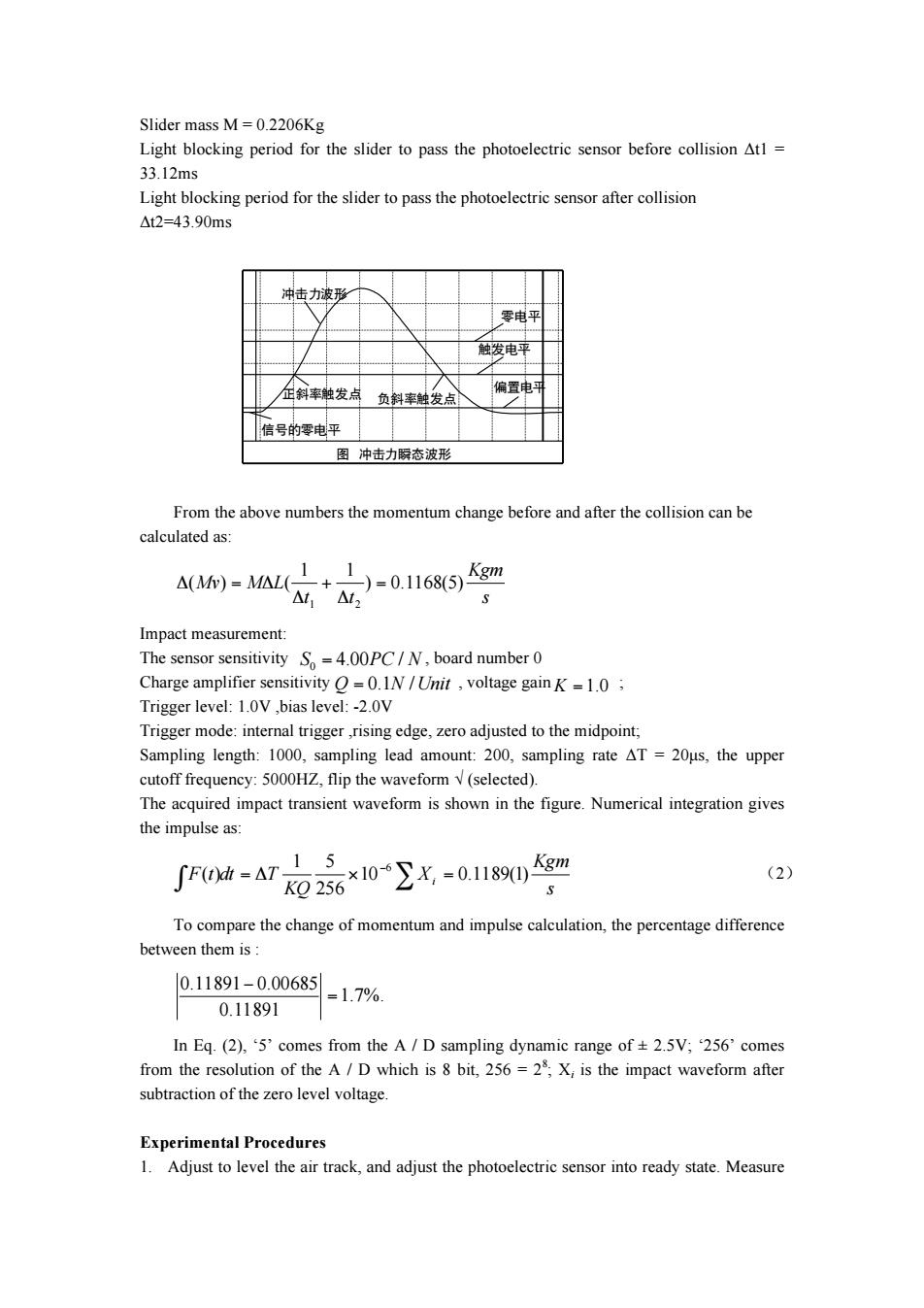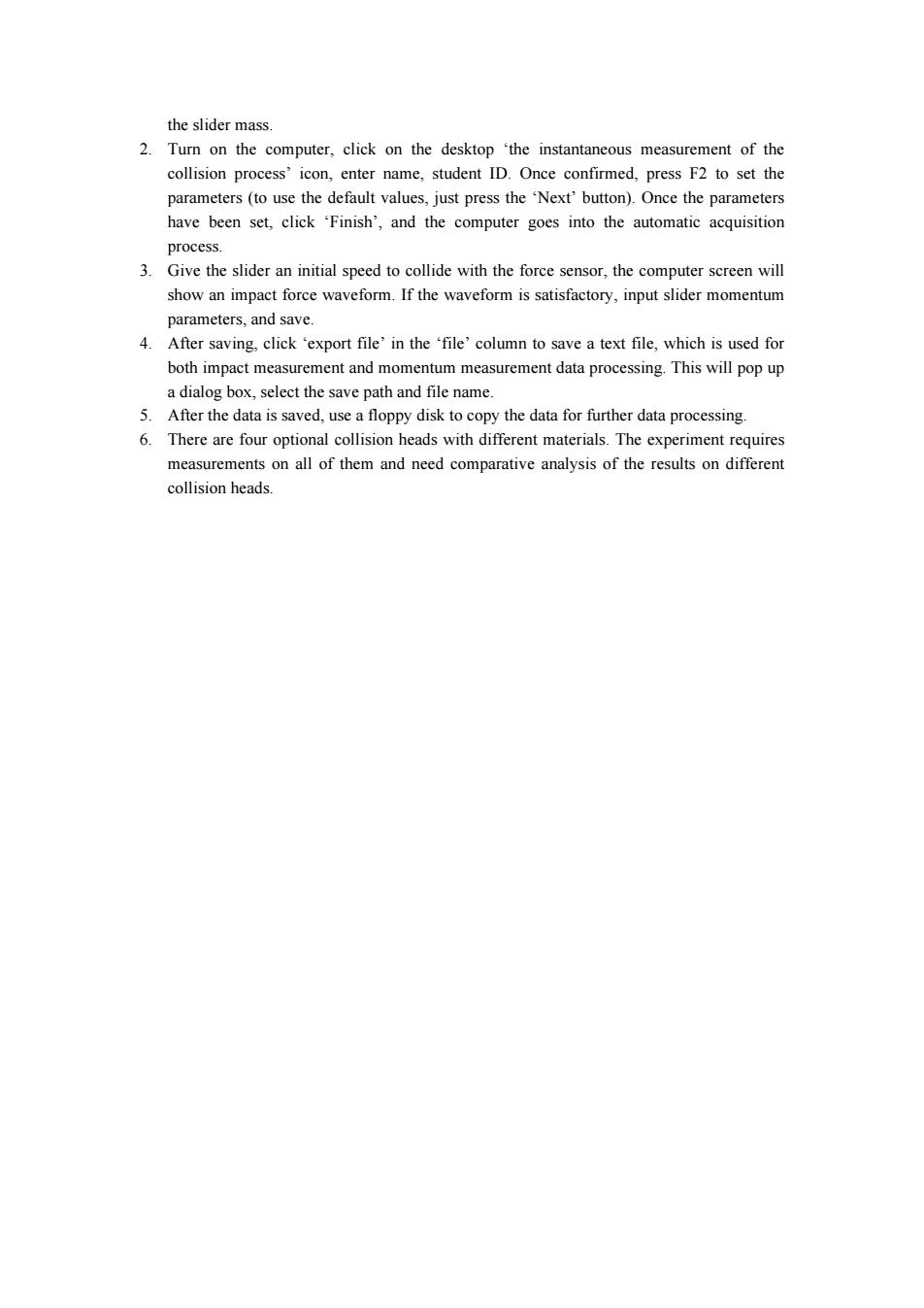
Dynamic Digital Measurement of the Impact Process Dynamic digital measurement of the impact process combines the force sensor and modern digital measuring technology in achieving the digital measurement of the dynamic impulsive force during impact event.It is both a basic training apparatus and a very general-purpose instrument with many practical applications.Force sensors,charge amplifier as well as transient data acquisition system can be widely used in general mechanical measurement,shock and vibration researches. Experimental Objective 1.Learn the principle and how to use the air track.Learn the principle of the light blocking board,photoelectric timer,instantaneous speed measurement mechanism,and the use of digital millisecond meter. 2.Get the physical picture of how the impact force varies with time during a collision process, deepening the understanding of basic concepts like momentum,collision and impulse. 3.Get some basic knowledge of modern sensor technology including the piezoelectric effect, sensing mechanism,and signal modulation. 4.Understand the characteristics and advantages of current digital technology through the transient signal recording and its conversion to actual physical constants. 5.Develop the ability to use computers for data processing by writing simple programs. Experimental Principle Collision and impact processes are usually instantaneous processes.Object momentum change before and after a collision subjects to the law of momentum: my-miF(dt (1) Traditional air track apparatus can not be used for the experimental verification of the law of momentum due to the difficulty in carrying out dynamical measurement of the impact force.This current system uses a piezoelectric force sensor to convert the force signal instantaneously into an electric signal and output it as a voltage signal after charge amplification. As long as we can measure the output voltage v(t)from the charge amplifier,we know the evolution of the impact force as function of time F(t). v(t)=GS F(t) GS is the conversion factor. Impact waveform obtained in the experiment normally assumes a half-sine shape as shown in the figure.In order to better understand how to obtain the instantaneous impulse,we listed in the following one sample measurement and the corresponding data analysis procedures. Momentum measurement: Slider block with light blocking bar spacing AL=1.000cm
Dynamic Digital Measurement of the Impact Process Dynamic digital measurement of the impact process combines the force sensor and modern digital measuring technology in achieving the digital measurement of the dynamic impulsive force during impact event. It is both a basic training apparatus and a very general-purpose instrument with many practical applications. Force sensors, charge amplifier as well as transient data acquisition system can be widely used in general mechanical measurement, shock and vibration researches. Experimental Objective 1. Learn the principle and how to use the air track. Learn the principle of the light blocking board, photoelectric timer, instantaneous speed measurement mechanism, and the use of digital millisecond meter. 2. Get the physical picture of how the impact force varies with time during a collision process, deepening the understanding of basic concepts like momentum, collision and impulse. 3. Get some basic knowledge of modern sensor technology including the piezoelectric effect, sensing mechanism, and signal modulation. 4. Understand the characteristics and advantages of current digital technology through the transient signal recording and its conversion to actual physical constants. 5. Develop the ability to use computers for data processing by writing simple programs. Experimental Principle Collision and impact processes are usually instantaneous processes. Object momentum change before and after a collision subjects to the law of momentum: ∫ − = t mv mv F t dt 0 0 ( ) (1) Traditional air track apparatus can not be used for the experimental verification of the law of momentum due to the difficulty in carrying out dynamical measurement of the impact force. This current system uses a piezoelectric force sensor to convert the force signal instantaneously into an electric signal and output it as a voltage signal after charge amplification. As long as we can measure the output voltage from the charge amplifier, we know the evolution of the impact force as function of time 。 v t GS F t ( ) = 0 ( ) is the conversion factor. Impact waveform obtained in the experiment normally assumes a half-sine shape as shown in the figure. In order to better understand how to obtain the instantaneous impulse, we listed in the following one sample measurement and the corresponding data analysis procedures. Momentum measurement : Slider block with light blocking bar spacing ΔL = 1.000cm v t( ) F t( ) GS0

Slider mass M=0.2206Kg Light blocking period for the slider to pass the photoelectric sensor before collision Atl 33.12ms Light blocking period for the slider to pass the photoelectric sensor after collision △t2=43.90ms 冲击力波形 零电平 触发电平 但斜率触发点负斜率触发点 偏置电平 信号的零电平 图冲击力瞬态波形 From the above numbers the momentum change before and after the collision can be calculated as: 11 △(Mw)=M△L( 4L+A)=0.11685)K8m △t1△t2 Impact measurement: The sensor sensitivity So=4.00PC/N,board number 0 Charge amplifier sensitivity =0.1N/Unit,voltage gainK=1.0; Trigger level:1.0V ,bias level:-2.0V Trigger mode:internal trigger,rising edge,zero adjusted to the midpoint, Sampling length:1000,sampling lead amount:200,sampling rate AT=20us,the upper cutoff frequency:5000HZ,flip the waveform v(selected). The acquired impact transient waveform is shown in the figure.Numerical integration gives the impulse as: K@256×10∑X,-0.11890Kgm ∫F0dt=A7L5 (2) S To compare the change of momentum and impulse calculation,the percentage difference between them is: 0.11891-0.00685 =1.7%. 0.11891 In Eq.(2),5'comes from the A/D sampling dynamic range of 2.5V;256'comes from the resolution of the A /D which is 8 bit,256=28;X;is the impact waveform after subtraction of the zero level voltage. Experimental Procedures 1.Adjust to level the air track,and adjust the photoelectric sensor into ready state.Measure
Slider mass M = 0.2206Kg Light blocking period for the slider to pass the photoelectric sensor before collision Δt1 = 33.12ms Light blocking period for the slider to pass the photoelectric sensor after collision Δt2=43.90ms 图 冲击力瞬态波形 信号的零电平 正斜率触发点 负斜率触发点 触发电平 偏置电平 零电平 冲击力波形 From the above numbers the momentum change before and after the collision can be calculated as: s Kgm t t Mv M L ) 0.1168(5) 1 1 ( ) ( 1 2 = Δ + Δ Δ = Δ Impact measurement: The sensor sensitivity , board number 0 Charge amplifier sensitivity , voltage gain ; Trigger level: 1.0V ,bias level: -2.0V Trigger mode: internal trigger ,rising edge, zero adjusted to the midpoint; Sampling length: 1000, sampling lead amount: 200, sampling rate ΔT = 20µs, the upper cutoff frequency: 5000HZ, flip the waveform √ (selected). The acquired impact transient waveform is shown in the figure. Numerical integration gives the impulse as: s Kgm X KQ F t dt T i 10 0.1189(1) 256 1 5 ( ) 6 = Δ × ∑ = ∫ − (2) To compare the change of momentum and impulse calculation, the percentage difference between them is : 1.7% 0.11891 0.11891 0.00685 = − . In Eq. (2), ‘5’ comes from the A / D sampling dynamic range of ± 2.5V; ‘256’ comes from the resolution of the A / D which is 8 bit, 256 = 28 ; Xi is the impact waveform after subtraction of the zero level voltage. Experimental Procedures 1. Adjust to level the air track, and adjust the photoelectric sensor into ready state. Measure 0 S PC N = 4.00 / Q N Unit = 0.1 / K = 1.0

the slider mass. 2.Turn on the computer,click on the desktop 'the instantaneous measurement of the collision process'icon,enter name,student ID.Once confirmed,press F2 to set the parameters(to use the default values,just press the Next'button).Once the parameters have been set,click Finish',and the computer goes into the automatic acquisition process. 3.Give the slider an initial speed to collide with the force sensor,the computer screen will show an impact force waveform.If the waveform is satisfactory,input slider momentum parameters,and save. 4.After saving,click 'export file'in the 'file'column to save a text file,which is used for both impact measurement and momentum measurement data processing.This will pop up a dialog box,select the save path and file name. 5.After the data is saved,use a floppy disk to copy the data for further data processing. 6.There are four optional collision heads with different materials.The experiment requires measurements on all of them and need comparative analysis of the results on different collision heads
the slider mass. 2. Turn on the computer, click on the desktop ‘the instantaneous measurement of the collision process’ icon, enter name, student ID. Once confirmed, press F2 to set the parameters (to use the default values, just press the ‘Next’ button). Once the parameters have been set, click ‘Finish’, and the computer goes into the automatic acquisition process. 3. Give the slider an initial speed to collide with the force sensor, the computer screen will show an impact force waveform. If the waveform is satisfactory, input slider momentum parameters, and save. 4. After saving, click ‘export file’ in the ‘file’ column to save a text file, which is used for both impact measurement and momentum measurement data processing. This will pop up a dialog box, select the save path and file name. 5. After the data is saved, use a floppy disk to copy the data for further data processing. 6. There are four optional collision heads with different materials. The experiment requires measurements on all of them and need comparative analysis of the results on different collision heads